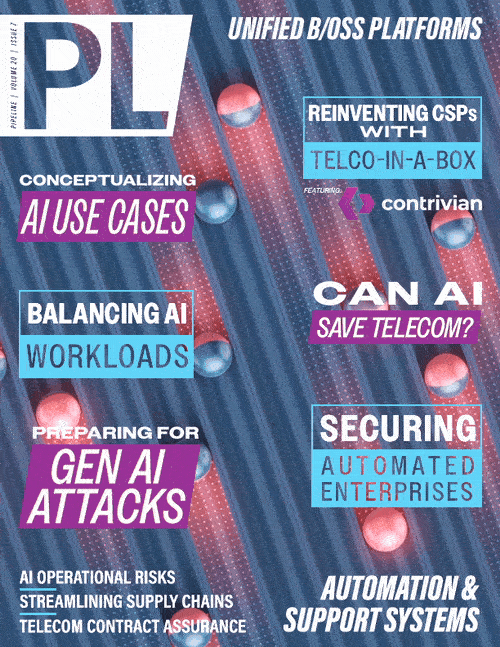Can Generative AI Become the Saviour
of the Telecoms Industry?
Netcracker has already publicly announced the deployment of the GenAI Telco Solution with T-Mobile USA, who plans to use the technology to provide a better experience to its partners in its wholesale business.
ENEA: Don’t Forget GenAI can also Create Security Risks in the Network
For ENEA’s VP of Technology, Cathal McDaid, AI and GenAI, create a number of new cyber security concerns. Like many industry leaders, ENEA can see huge opportunities with AI, but of course these come with new risks. We are already seeing the use of AI/GenAI in criminality. The ability of AI to create voice fakes, video fakes and image fakes has the potential to make anything we do online less safe. ENEA believes that to generate the benefits of AI within telecoms it is also incumbent on the industry to improve security. One approach is to introduce deep packet inspection, DPI, into many processes. They also believe that Quantum computing, at a nascent stage, will bring even more threats, and that future telecom networks must be “Quantum security ready.
Security needs to be improved in four main areas: signalling security; voice security (spoofing); infrastructure; and 5G rollout. Globally, telecom regulators need to be doing more to encourage future-thinking and thought leadership in telecom security. Many countries consider their fixed and mobile networks as “Critical National Infrastructure” (CNI), but think that not enough is being done to protect those networks. Another major consideration is around the Wi-Fi infrastructure in homes and offices. Currently around 80 percent of 4G traffic is offloaded over Wi-Fi networks, but those Wi-Fi routers and infrastructure are routinely ignored. Security must be end-to-end.
Amdocs: It’s all about Training and Efficiency
Yaron Sverdlov, Service Group CTO at Amdocs, explained more about the introduction of amAIz as their Telco GenAI solution. amAIz is not another large language model (LLM). It is a “context aware platform supporting multiple LLMs, with security and a studio for developing use cases.” Effectively, amAIz is an AI platform trained for the telco context.
According to Amdocs, the aim of amAIz is two-fold. Firstly, to improve productivity, what they call: “doing what you do today better.” And secondly, its aim is to “enable service providers to do new things,” using what they call “sentient analysis.”
Amdocs is customizing existing enterprise LLMs using NVIDIA-accelerated computing. They are collaborating with both NVIDIA and Microsoft to produce aTelco GenAI Platform. However, they stressed that this development requires considerable investment in people and skills with new capabilities such as data science, LLM training, and prompt engineering being some of the new skills required to work in the GenAI domain.
Rocks in the AI Road
We’ve seen that the industry expects AI to have a huge, transformational impact on the industry. But what could go wrong? The telco industry is hugely pragmatic and cautious about the “next best thing in technology” and its true impact. The industry is keen to highlight that there are a number of issues that could impact AI having the expected transformational effect. These included:
Doing things differently – If you adopt transformational technology, you must also transform your culture, staff, and processes to maximize impact.
The art of partnering – The industry doesn’t always partner well and the ability to create true “win-win” partnerships is necessary.
Skills gaps – AI requires new jobs and skills sets. There is a requirement to train, retrain, and hire new staff to maximise the impact of AI. Do you have enough “Prompt Engineers”? Do you even know what a “Prompt Engineer” is?
Democratization of IT – In an AI future the IT organisation can’t be the bottleneck in the process. It needs to provide “guard rails,” tools, and architecture, but also to allow other users to build products and services using AI.
Expect the AI bubble to burst – AI and GenAI is at the top of the “hype cycle” today. Service providers should expect to experience challenges and let-downs as they implement these technologies.
Don’t overthink implementing GenAI – Many service providers are reluctant to experiment and may want to wait until the technology is mature before trying it themselves. GenAI can have huge impacts on productivity, and this gives first-movers a clear advantage. In other words, don’t wait too long to adopt the technology.
Security – How do you control access to the model? How do you prevent model poisoning? And how do you prevent private data being accessed through open public models. For GenAI to be successful, data must be secure and data breaches prevented.
AI combined with the power of the network will be immensely powerful. This combination puts telcos or CSPs in a strong position to take a leading role and benefit from the $15 trillion AI market. But change is hard, and not everyone will be able to make that transformation.



















